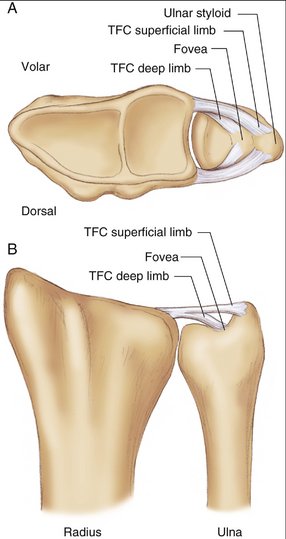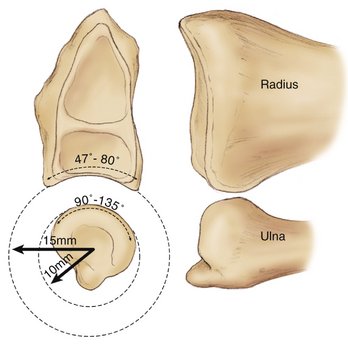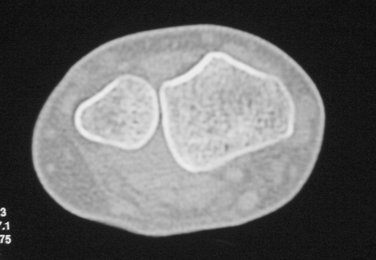CHAPTER 29 Ligament Reconstruction/Sigmoid Notch Plasty for DRUJ Instability
The bony or ligamentous structures of the distal radioulnar joint (DRUJ) are often disrupted in association with a distal radius fracture, which is the most common cause for DRUJ instability. In some studies, up to 10% of patients with distal radius fractures had a DRUJ injury necessitating primary operative repair.1 In addition, arthroscopy at the time of fracture identified the presence of triangular fibrocartilage complex (TFCC) injury in 43 of 51 patients examined by Lindau and colleagues.2 The TFCC lesions were associated with DRUJ instability in 17 patients. Younger patients and those sustaining high-energy injuries are more likely to have DRUJ injuries in association with distal radius fractures.2
Failure to recognize and treat DRUJ disruption can contribute to a poor outcome. In particular, residual DRUJ instability after distal radius fracture is associated with worse objective and subjective outcome measures.3 When treated acutely by either closed reduction or soft tissue or bony repair, most patients will not develop DRUJ instability. However, some patients with distal radius fractures will go on to develop chronic DRUJ instability owing to failure of the soft tissues to heal or to malunion of the radius or ulna (Fig. 29-1). Multiple techniques have been described to restore stability to the chronically unstable DRUJ. These techniques can be divided into three categories: (1) a direct radioulnar tether that is extrinsic to the joint, (2) an indirect radioulnar link through an ulnocarpal sling or tenodesis, or (3) reconstruction of the distal radioulnar ligaments.
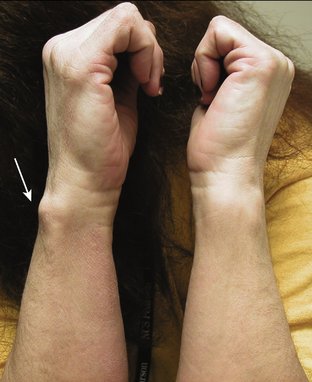
FIGURE 29-1 Chronic DRUJ instability after a distal radius fracture. Arrow points to the prominent ulnar head on the affected side.
Multiple biomechanical studies have shown that the dorsal and palmar radioulnar ligaments are key stabilizers of the DRUJ.4,5 The radioulnar ligaments are condensations of fibers at the combined junctures of the triangular fibrocartilage articular disc, DRUJ capsule, and ulnocarpal capsule. As they pass toward the ulna, each ligament divides into superficial and deep fibers (Fig. 29-2). The superficial fibers insert on the ulnar styloid near its midportion. Disruption of the superficial fibers in the absence of other injury does not result in DRUJ instability. The deep radioulnar ligament fibers insert into the fovea on the ulnar head, which is a bony depression between the base of the styloid and the articular cartilage on the dome of the ulnar head. Disruption of these fibers can result in DRUJ instability.
Because of the importance of the dorsal and palmar radioulnar ligaments for DRUJ stability, reconstruction of these ligaments offers the best anatomical restoration of joint stability. The technique described in this chapter uses a tendon graft that nearly mimics the native ligaments. The two limbs of the tendon graft pass from the volar and dorsal margins of the sigmoid notch and converge to insert on the ulnar head at the fovea (Fig. 29-3). A recent biomechanical study by Gofton and coworkers6 found that this radioulnar ligament reconstruction nearly restored the kinematics of the unstable DRUJ, and it provided better joint stability than the nonanatomical reconstruction described by Fulkerson-Watson, which has been shown to provide the best stability among the radioulnar tether methods.
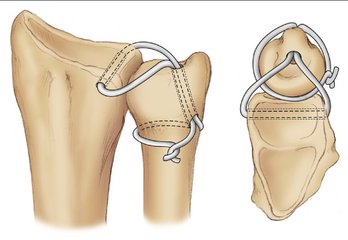
FIGURE 29-3 Final graft placement mimics the native insertion sites of the distal radioulnar ligaments.
Reconstruction of the soft tissue DRUJ restraints, however, will be insufficient in the presence of a substantial osseous abnormality. The articular surfaces of the DRUJ are not congruent in the normal wrist. The sigmoid notch has a radius of curvature that is much larger than that of the ulnar head (Fig. 29-4). It is a combination of ligament tension and joint compression between the ulnar head and rims of the notch that provides joint stability. The dorsal and particularly the volar rims of the notch often have fibrocartilaginous extensions or labrums that augment its relatively flat surface, which improves joint congruency and capture and thus substantially increases DRUJ stability.7 A developmentally flat notch or one that is deficient from injury poses greater risks to develop DRUJ instability and for the failure of a ligament reconstruction (Fig. 29-5). Sigmoid notch osteoplasty increases the prominence of the rim and improves joint stability.
Extra-articular deformity of the radius alone is sufficient to substantially impair DRUJ function. In cadaver studies, dorsal angulation of the distal radius or loss of radial inclination alters DRUJ mechanics and reduces forearm rotation.8,9 Corrective osteotomy of the radius can be performed in conjunction with a radioulnar ligament reconstruction.
Indications
Computed tomography (CT) should be performed if there is any question regarding the competency of the sigmoid notch or the presence of arthritis. CT is performed on both wrists in equivalent neutral, pronation, and supination positions. The comparison between sides will help assess direction of instability and if the shape of the notch has been altered by injury. If the notch is developmentally flat or a rim has been traumatically damaged, a sigmoid notch osteoplasty at the time of ligamentous reconstruction may be necessary.

